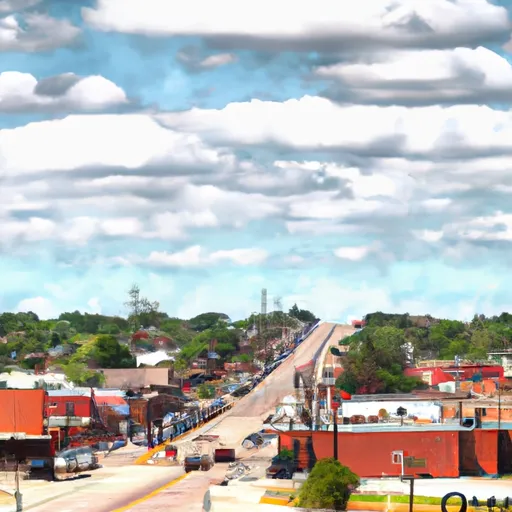-
 Snoflo Premium
Snoflo Premium
Get unlimited access to all our content
With no Ad interruptions! - Start Your Free Trial Login with existing account
Okarche
Eden Index
Climate
8.3
•
Recreation
2.2
•
Community
3.1
•
Safeguard
4.8/10

Okarche, Oklahoma is a small town located in Canadian County. The climate in Okarche is characterized by hot summers and mild winters. Summers are typically hot and humid, with temperatures often exceeding 90°F. Winters are relatively mild, with average temperatures ranging from the mid-30s to the mid-50s°F.
Hydrologically, Okarche lies in the Central Oklahoma Plains region and is not directly adjacent to any major bodies of water. However, it is part of the broader hydrological system of the Central Oklahoma Plains, which includes numerous streams and rivers.
Outdoor recreation opportunities in Okarche include fishing in local ponds and lakes, such as the Okarche City Park Pond, where anglers can catch bass, catfish, and sunfish. The town also has several parks and sports fields for activities like baseball, softball, and soccer. Additionally, Okarche is surrounded by beautiful countryside, making it ideal for hiking, biking, and exploring nature.
What is the Eden Index?
The Snoflo Eden Index serves as a comprehensive rating system for regions, evaluating their desirability through a holistic assessment of climate health, outdoor recreation opportunities, and natural disaster risk, acknowledging the profound impact of these factors on livability and well-being.
Climate Health Indicator (CHI): 8.3
Okarche receives approximately
850mm of rain per year,
with humidity levels near 80%
and air temperatures averaging around
16°C.
Okarche has a plant hardyness factor of
7, meaning
plants and agriculture in this region tend to thrive during the non-winter months.
By considering the ideal temperature range, reliable water supplies, clean air, and stable seasonal rain or snowpacks, the Climate Health Indicator (CHI) underscores the significance of a healthy climate as the foundation for quality living.
A healthy climate is paramount for ensuring a high quality of life and livability in a region, fostering both physical well-being and environmental harmony. This can be characterized by ideal temperatures, reliable access to water supplies, clean air, and consistent seasonal rain or snowpacks.
Weather Forecast
Streamflow Conditions
Lower Cimarron
Area Rivers
Lower Cimarron
Snowpack Depths
Lower Cimarron
Reservoir Storage Capacity
Lower Cimarron
Groundwater Levels
Recreational Opportunity Index (ROI): 2.2
The Recreational Opportunity Index (ROI) recognizes the value of outdoor recreational options, such as parks, hiking trails, camping sites, and fishing spots, while acknowledging that climate plays a pivotal role in ensuring the comfort and consistency of these experiences.
Access to outdoor recreational opportunities, encompassing activities such as parks, hiking, camping, and fishing, is crucial for overall well-being, and the climate plays a pivotal role in enabling and enhancing these experiences, ensuring that individuals can engage in nature-based activities comfortably and consistently.
Camping Areas
| Campground | Campsites | Reservations | Toilets | Showers | Elevation |
|---|---|---|---|---|---|
| Schrock Park | None | 1,305 ft | |||
| Anthony City Lake | 66 | 1,343 ft | |||
| Lake Chickasha | 50 | 1,207 ft | |||
| Clear Creek Lake | None | 1,181 ft | |||
| Great Salt Plains State Park | None | 1,144 ft | |||
| Moneka Park - Waurika Lake | None | 906 ft | |||
| Chisolm Trail Ridge - Waurika Lake | None | 975 ft | |||
| Kiowa Park - Waurika Lake | None | 979 ft | |||
| Wichita Ridge - Waurika Lake | None | 1,001 ft | |||
| Taylor Lake | 20 | 1,289 ft |
Nearby Ski Areas
Catastrophe Safeguard Index (CSI):
The Catastrophe Safeguard Index (CSI) recognizes that natural disaster risk, encompassing floods, fires, hurricanes, and tornadoes, can drastically affect safety and the overall appeal of an area.
The level of natural disaster risk in a region significantly affects safety and the overall livability, with climate change amplifying these risks by potentially increasing the frequency and intensity of events like floods, fires, hurricanes, and tornadoes, thereby posing substantial challenges to community resilience and well-being.
Community Resilience Indicator (CRI): 3.1
The Community Resilience Indicator (CRI) recognizes that education, healthcare, and socioeconomics are crucial to the well-being of a region. The CRI acknowledges the profound impact of these elements on residents' overall quality of life. By evaluating educational resources, healthcare accessibility, and economic inclusivity, the index captures the essential aspects that contribute to a thriving community, fostering resident satisfaction, equity, and social cohesion.

